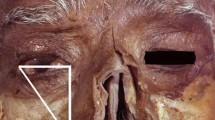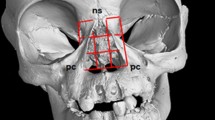Abstract
Infraorbital nerve blocking through the infraorbital foramen and infraorbital canal is used to anesthetize the lower eyelid, upper lip, lateral nose, upper teeth and related gingivae. For this, it is important to know the position of the infraorbital foramen, structures around the foramen, and the direction of the injecting needle related to the angle of the infraorbital canal. Many reports have described the anatomical location of the infraorbital foramen; however, not many have described the angle of the infraorbital canal and those structures around the infraorbital foramen that help the physician visualize the correct direction of the needle. Dried skulls of 42 Korean subjects (27 male and 15 female) were studied to analyze structures around the infraorbital foramen. The morphology of the infraorbital canal was also investigated using three-dimensional models. Structures around the infraorbital foramen were classified into four types according to the existence of a distinct tuberosity above the infraorbital foramen, and the degree of prominence of the canine fossa. Types I and II have a tuberosity above the infraorbital foramen, whereas types III and IV have no distinct tuberosity. Types I and III have a prominent canine fossa, whereas this is less prominent in types II and IV. We analyzed the skulls based on the angle of the infraorbital canal to the median plane. We compared the left and right sides and analyzed differences between the sexes, the three canal shapes, and the four structure types around the infraorbital foramen. Type IV was the most common in this series (38%). The infraorbital canal could be classified into three morphologies: ‘tube-like’ (69%), ‘funnel’ (25%) and ‘pinched’ (6%). The mean angle of the infraorbital canal relative to the median plane was 12°, and the angle relative to the Frankfurt plane was 44°. The mean angle between the infraorbital canal and the Frankfurt plane was 4° larger in males than in females in this series of Korean subjects. The operator of the infraorbital nerve block should pay attention towards directing the needle upward at an angle of about 44° for avoiding nerve damage and consider the different angles of the canal according to the individual’s sex.






Similar content being viewed by others
References
Aziz S, Marchena JM, Puran A (2000) Anatomic characteristics of the infraorbital foramen: a cadaver study. J Oral Maxillofac Surg 58:992–996
Barash PG, Cullen BF, Stoelting RK (2001) Clinical Anesthesia, 4th edn. Lippincott Williams & Wilkins, Philadelphia, p 718
Blanton PL, Jeske AH (2003) The key to profound local anesthesia. J Am Dent Assoc 134:753–760
Canan S, Asim OM, Okan B et al (1999) Anatomic variations of the infraorbital foramen. Ann Plast Surg 43:613–617
Chung MS, Kim HJ, Kang HS, Chung IH (1995) Locational relationship of the supraorbital notch or foramen and infraorbital and mental foramina in Koreans. Acta Anat 154:162–166
Fanning GL (2000) Local anaesthesia for dacryocystorhinostomy. Curr Anaesth Crit Care 11:306–309
Gershenson A, Nathan H, Luchansky E (1986) Mental foramen and mental nerve: changes with age. Acta Anat 126:21–28
Jacobs JJ (1989) Shearer’s manual of human dissection, 7th edn. McGraw-Hill Information Services Company, New York, pp 46–47
Kazkayasi M, Ergin A, Ersoy M, Bengi O et al (2001) Certain anatomical relations and the precise morphometry of the infraorbital foramen-canal and groove: an anatomical and cephalometric study. Laryngoscope 111:609–614
Kim MK (1993) A clinical and anatomical study on the infraorbital foramen and infraorbital canal in Korean. Korean J Phys Anthrop 6:101–110
Kleier DJ, Deeg DK, Averbach RE (1983) The extra oral approach to the infraorbital nerve block. J Am Dent Assoc 107:758–760
Miller RD (2000) Anesthesia, 5th edn. Churchill Livingstone, Philadelphia, p 1540
Moore KL, Dalley AF II (1999) Clinically oriented anatomy, 4th edn. Lippincott Williams & Wilkins, Philadelphia, p 861
Radojevic V (1969) Study of projection of supraorbital, suborbital and mental orifice for the purpose of anesthesia of corresponding nerves. Srp Arh Celok Lek 97:605–610
Salam GA (2004) Regional anesthesia for office procedures. Part I. Head and neck surgeries. Am Fam Physician 69:585–590
Webster RC, Gaunt JM, Hamdan US et al (1986) Supraorbital and supratrochlear notches and foramina: anatomical variations and surgical relevance. Laryngoscope 96:311–315
Wilkinson HA (1999) Trigeminal nerve peripheral branch phenol/glycerol injections for tic douloureux. J Neurosurg 90:828–832
Williams PL, Warwick D, Dyson M, Bannister LH (1989) Gray’s anatomy, 37th edn. Churchill-Livingstone, Edinburgh, pp 343, 369–370, 387
Woodburne RT, Burkel WE (1994) Essentials of human anatomy, 9th edn. Oxford University Press, New York, p 316
Acknowledgements
This work was supported by grant No. 2004-JUNGJI-E24 from Korea Institute of Science and Technology Information and Ministry of Information and Communication Republic of Korea.
Author information
Authors and Affiliations
Corresponding author
Rights and permissions
About this article
Cite this article
Lee, UY., Nam, SH., Han, SH. et al. Morphological characteristics of the infraorbital foramen and infraorbital canal using three-dimensional models. Surg Radiol Anat 28, 115–120 (2006). https://doi.org/10.1007/s00276-005-0071-y
Received:
Accepted:
Published:
Issue Date:
DOI: https://doi.org/10.1007/s00276-005-0071-y




